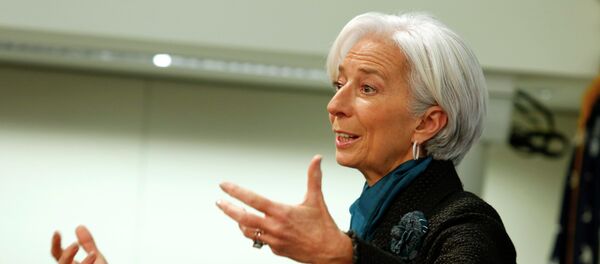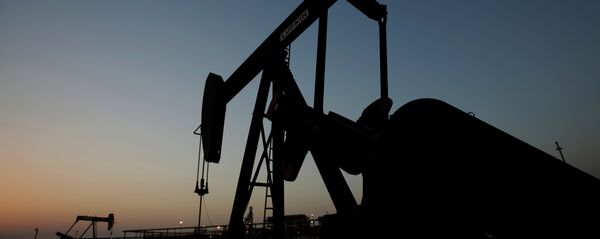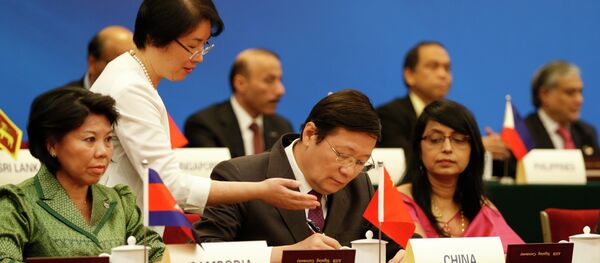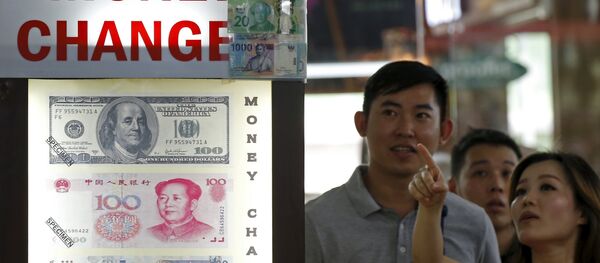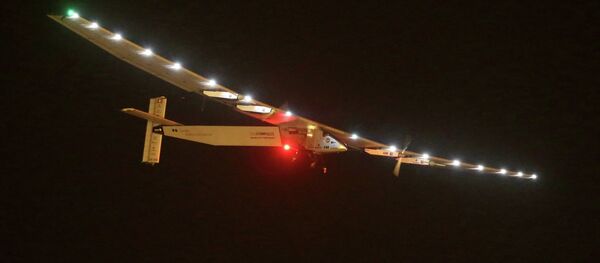MOSCOW (Sputnik), Ivan Kuzevanov — Among them there was the creation of new institutions and the launching of reforms in old ones, challenging the international financial framework formed in the 1940s, a commodity-price revolution in global markets, and attempts to make universal practical steps toward a more sustainable world economy.
Poles Apart
Although growth in overall economic output in the world slowed (according to the IMF’s October World Economic Outlook, in 2015 growth is expected to diminish from 2014's 3.4 percent to 3.1 percent), most developed countries managed to maintain or increase last year's pace.
According to the European Commission Economic Forecast, released in November, real GDP in the euro area is projected to grow by 1.6 percent in 2015, entering a period of a "modest" economic growth. Last year growth in the single-currency zone reached 0.9 percent after two years of recession.
According to the US Commerce Department, the GDP of the United States is expected to advance in 2015 at about 2.5 percent, similar to that seen last year (2.4 percent).
At the same time, the International Monetary Fund forecasts weaker Chinese economic growth, slipping back from 7.3 percent in 2014 to 6.8 in 2015 and 6.3 percent in 2016, while such developing economies as Russia and Brazil are expected to shrink by 3.8 and 3 percent respectively in 2015 and by 0.6 and 1 percent in 2016.
Oil: Lasting Free Fall
In 2014, the price of Brent Crude oil, which reached a high of some $115 per barrel in June, plummeted to $60 per barrel in December. The year 2015 demonstrated that the low experienced then was to continue, helped in no small way by policies pursued by the Organization of the Petroleum Exporting Countries (OPEC).
In line with the decision taken in November 2014, when the cartel, whose 12 member states account for over a third of the world’s oil output, decided against trying to boost oil prices through production cuts, OPEC upheld its production quota of 30 million barrels per day at its meeting in Vienna on June 5.
Reacting on OPEC's decision, Brent prices dipped below $37.5 a barrel, just a dollar above levels last seen in December 2008.
According to an IMF forecast, considering the resilient supply, the prospects of higher future output following the nuclear deal with Iran, and weaker global demand, particularly due to a projected continuation of the slowdown in China, the average oil spot price is not expected to exceed $60 before 2019. This will create difficult external conditions for commodity exporters who are feeling the sharp appreciation of the US dollar and are reducing in public spending accordingly, as well as providing some uptake in demand among commodity importers.
New Development Banks
China, along with its BRICS partners, continued its 2014 efforts to create alternatives to traditionally Western-oriented international financial institutions.
The New Development Bank (NDB), created in July 2014 by the BRICS member states — Brazil, Russia, India, China and South Africa — to mobilize resources for infrastructure and sustainable development projects, with a currency pool of $100 billion, began operations in Shanghai, China's largest city, on July 21.
Prior to the launch, in July 2015, the five emerging economies’ central banks signed an operating agreement on the NDB currency reserve pool at the BRICS summit in the southwest Russian city of Ufa. As President-designate of the BRICS New Development Bank Kundapur Vaman Kamath told Sputnik at the summit, the NDB is expected to approve its first infrastructure projects in April 2016.
Preparations for launching the Asian Infrastructure Investment Bank (AIIB), an international financial institution proposed by China the the aim of investing in infrastructure projects in the Asia-Pacific region, also made great progress in 2015.
In August, the AIIB supervisory board elected China's former Vice Finance Minister Jin Liqun as the bank's first president. In early December, AIIB's deputy head Chen Huan said the bank, whose three major shareholders are China, India and Russia, would commence operations in mid-January 2016.
Among other Chinese-led initiatives, the development of the Silk Road Economic Belt project, initiated by Chinese President Xi Jinping in 2013 and set to be partially financed by AIIB, cannot be omitted.
The Silk Road Economic Belt comprises multiple energy and infrastructure projects, including the construction of new railroads, highways and industrial parks, in the coming years.
In March, China revealed that the framework of the project was expected to be complimented by the 21st-Century Maritime Silk Road, connecting China with Europe via the Indian Ocean, while facilitating trade and cooperation with the South Pacific region. Xi Jinping said that over 60 countries along the routes have shown interest in taking part in the development of the Belt and the Road. The Chinese President also said that he hoped that annual trade between China and other Silk Road countries would exceed $2.5 trillion within a decade.
In May, China and Russia signed a joint declaration on the construction of the Silk Road Economic Belt and on Eurasian Economic Union docking cooperation, in which they pledged to cooperate closely on the projects.
Yuan Recognition
Multiple ambitious project with Chinese financing and the global effect of the Chinese slowdown enabled Beijing to reaffirm China’s major role in the international economy. The inclusion of the Chinese yuan, also known as the renminbi (RMB), in the IMF’s basket of reserve currencies should be viewed as recognition of this role.
On November 30, IMF Managing Director Christine Lagarde announced that the yuan is set to officially become a reserve currency from October 2016. The Chinese currency’s inclusion is expected to contribute to the value of the Special Drawing Rights — a weighted average of the currencies — which the IMF uses to price its emergency loans.
The weight of the Chinese yuan in the reviewed basket of currencies will be 10.92 percent, while the share of the US dollar will remain 41.73 percent.
The Yuan also continued to play an important role in expanding the use of national currencies in international trade this year. In October, Beijing launched the China International Payments System (CIPS), as alternative to the western SWIFT (Society for Worldwide Interbank Financial Telecommunication) payment system, while a month earlier Russian President Vladimir Putin said that Moscow and Beijing were set to intensify their financial cooperation, specifically, they plan to start using national currencies in mutual payments.
Reshuffling of Powers in IMF
The G20 states, including BRICS countries, continued insistently to call for deep reforms to the IMF. In 2010, the G20 group of countries agreed to gradually shift voting power to dynamic emerging market nations such as China, India, Brazil and Turkey. However, the move has not been implemented and in February 2015, the G20 finance ministers and central bank governors stated that they were disappointed by the delays in reforming the IMF quota system.
The IMF uses a quota formula to determine member country contributions, voting power and access to financing, according to the fund. At present, the IMF members with the largest quotas are the United States, Japan and Germany.
The BRICS leaders, expressing their deep disappointment at the lack of progress in modernizing international financial institutions, "urged the IMF – in cooperation with its membership – to step up efforts in collaboration with the G20 to find such solutions that would ultimately make it possible to increase the institution’s quota resources and review the distribution of quotas and votes in favor of developing countries and emerging market economies."
The call was later supported in the G20 communique, calling the 2010 reforms of the "highest priority."
'Toxic' Trade Deals
In 2015, Washington continued its policy of concluding mega-regional agreements. The United States launched secretive trade and services deregulation talks with other countries outside the framework of the WTO after the Doha Development Agenda stalled in 2008 amid disagreement between advanced and developing nations over agriculture, services and tariffs.
In October, Washington and 11 other countries of the Pacific Rim region — Chile, Canada, Australia, Japan, New Zealand, Mexico, Taiwan, South Korea, Brunei, Singapore and Malaysia — reached an agreement on the Trans-Pacific Partnership (TPP) free trade deal, which will cover about 40 percent of the global economy once ratified.
However, representatives of civil society around the world opposed the agreement due to concerns over the uncertain implications of the deal on workers’ rights, national sovereignty, employment, copyright laws and the environment.
Another direction of US trade policy development is the Transatlantic Trade and Investment Partnership (TTIP) deal that aims to streamline the flow of goods and services across the Atlantic. The pact seeks to create the world's largest deregulated trade zone, encompassing over 60 percent of global production.
Following the week-long 11th round of TTIP talks in Miami, Florida, in October, the European Commission made public its proposals for a chapter on trade and sustainable development, including on labor and the environment and finalized its approach to protecting investors and resolving investment, in an effort to assuage public concerns about the deal.
The 12th round of the US-EU talks is due to be held in early 2016 with the aim of drafting the full text of the agreement before the end of the year. Earlier this month, German Chancellor Angela Merkel said it was the European Union’s objective to sign an agreement on a free trade zone with the United States before the end of the presidency of US President Barack Obama in January 2017.
TiSA opponents point out that the controversial deal seeks primarily to deregulate trade in sectors favorable to Washington, paving the way for supranational labor laws, as well as financial and industrial policies that undermine a sovereign governments' ability to protect its citizens. Uruguay and Paraguay announced in September that they had decided to pull out of the multilateral negotiations.
During the 15th round of negotiations on the deal in December 2015, the parties focused on financial services, domestic regulation and transparency in legislative processes and the movement of natural persons as services suppliers, among other issues. Five more rounds of talks are planned for 2016.
Climate to Change Economy
One of the main events of 2015, which could potentially have the most far-reaching consequences for the future of the world economy, happened in December in Paris where official representatives of nearly 200 countries reached a deal to make economic development more sustainable.
The Paris Climate Change Conference, held on November 30 — December 11, was expected to result in a global agreement on the measures necessary to prevent global warming from exceeding 1.5 degrees Celsius, including targets for greenhouse gas emission cuts, as an increase of average global temperatures of 2 degrees or more has been scientifically proven to have disastrous consequences for the planet.
The text of the deal urges the 195 UN member nations to "pursue efforts" to limit global warming to 1.5 degrees Celsius above pre-industrial levels and makes submitting emissions reduction targets legally binding.
UN Secretary-General Ban Ki-moon said striking the Paris accord has been the ultimate goal of his nine-year tenure. The Paris Agreement will be signed in the UN headquarters on Earth Day, April 22, 2016.


